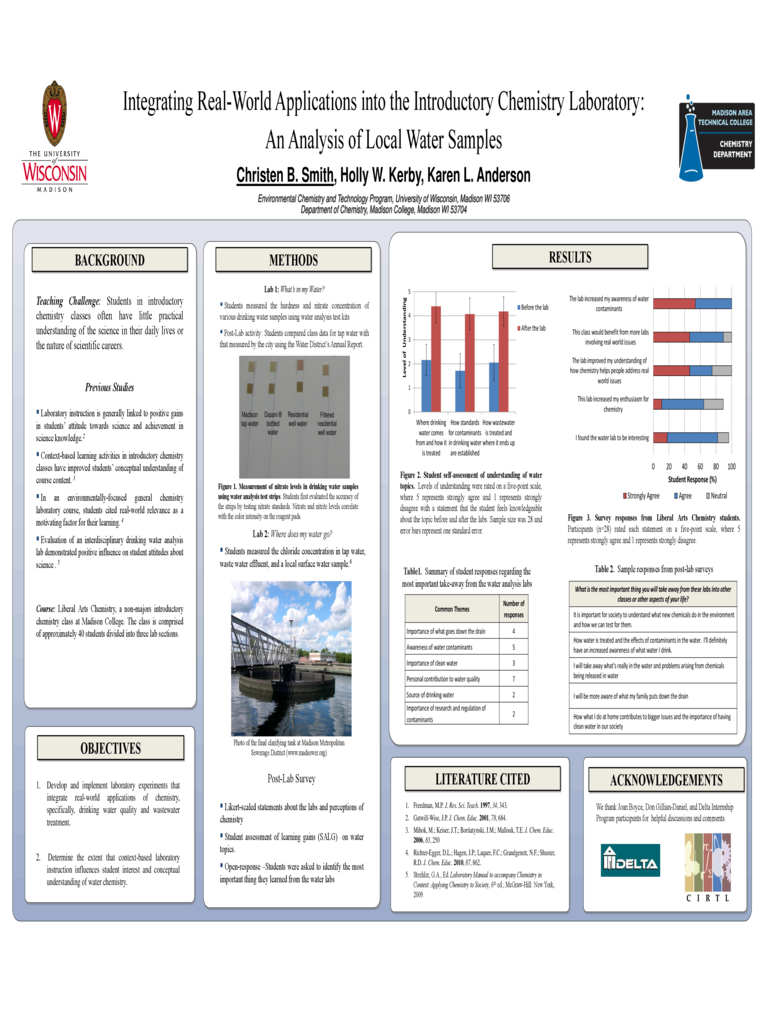Fillable Printable Chemistry Poster Template
Fillable Printable Chemistry Poster Template

Chemistry Poster Template

Integrating Real-World Applications into the Introductory Chemistry Laboratory:
An Analysis of Local Water Samples
Christen B. Smith, Holly W. Kerby, Karen L. Anderson
Environmental Chemistry and Technology Program, University of Wisconsin, Madison WI 53706
Department of Chemistry, Madison College, Madison WI 53704
BACKGROUND METHODS
RESULTS
OBJECTIVES
ACKNOWLEDGEMENTS
LITERATURE CITED
0
1
2
3
4
5
Where drinking
water comes
from and how it
is treated
How standards
for contaminants
in drinking water
are established
How wastewater
is treated and
where it ends up
Level of Understanding
Before the lab
After the lab
Common Themes
Number of
responses
Importance of what goes down the drain
4
Awareness of water contaminants
5
Importance of clean water
3
Personal contribution to water quality
7
Source of drinking water
2
Importance of research and regulation of
contaminants
2
0 20 40 60 80 100
I found the water lab to be interesting
This lab increased my enthusiasm for
chemistry
The lab improved my understanding of
how chemistry helps people address real
world issues
This class would benefit from more labs
involving real world issues
The lab increased my awareness of water
contaminants
Student Response (%)
Strongly Agree
Agree
Neutral
What is the most important thing you will take away from these labs into other
classes or other aspects of your life?
It is important for society to understand what new chemicals do in the environment
and how we can test for them.
How water is treated and the effects of contaminants in the water. I'll definitely
have an increased awareness of what water I drink.
I will take away what's really in the water and problems arising from chemicals
being released in water
I will be more aware of what my family puts down the drain
How what I do at home contributes to bigger issues and the importance of having
clean water in our society
Teaching Challenge: Students in introductory
chemistry classes often have little practical
understanding of the science in their daily lives or
the nature of scientific careers.
Previous Studies
Laboratory instruction is generally linked to positive gains
in students’ attitude towards science and achievement in
science knowledge.
2
Context-based learning activities in introductory chemistry
classes have improved students’ conceptual understanding of
course content.
3
In an environmentally-focused general chemistry
laboratory course, students cited real-world relevance as a
motivating factor for their learning.
4
Evaluation of an interdisciplinary drinking water analysis
lab demonstrated positive influence on student attitudes about
science .
5
Course: Liberal Arts Chemistry, a non-majors introductory
chemistry class at Madison College. The class is comprised
of approximately 40 students divided into three lab sections.
1. Develop and implement laboratory experiments that
integrate real-world applications of chemistry,
specifically, drinking water quality and wastewater
treatment.
2. Determine the extent that context-based laboratory
instruction influences student interest and conceptual
understanding of water chemistry.
Lab 1: What’s in my Water?
Students measured the hardness and nitrate concentration of
various drinking water samples using water analysis test kits
Post-Lab activity: Students compared class data for tap water with
that measured by the city using the Water District’s Annual Report.
Post-Lab Survey
Likert-scaled statements about the labs and perceptions of
chemistry
Student assessment of learning gains (SALG) on water
topics.
Open-response –Students were asked to identify the most
important thing they learned from the water labs
Lab 2: Where does my water go?
Students measured the chloride concentration in tap water,
waste water effluent, and a local surface water sample.
6
1. Freedman, M.P. J. Res. Sci. Teach. 1997, 34, 343.
2. Gutwill-Wise, J.P. J. Chem. Educ. 2001, 78, 684.
3. Mihok, M.; Keiser, J.T.; Bortiatynski, J.M.; Mallouk, T.E. J. Chem. Educ.
2006, 83, 250
4. Richter-Egger, D.L.; Hagen, J.P.; Laquer, F.C.; Grandgenett, N.F.; Shuster,
R.D. J. Chem. Educ. 2010, 87, 862.
5. Steehler, G.A., Ed. Laboratory Manual to accompany Chemistry in
Context: Applying Chemistry to Society, 6
th
ed.; McGraw-Hill: New York,
2009.
Table 2. Sample responses from post-lab surveys
Table1. Summary of student responses regarding the
most important take-away from the water analysis labs
Figure 2. Student self-assessment of understanding of water
topics. Levels of understanding were rated on a five-point scale,
where 5 represents strongly agree and 1 represents strongly
disagree with a statement that the student feels knowledgeable
about the topic before and after the labs. Sample size was 28 and
error bars represent one standard error.
Figure 3. Survey responses from Liberal Arts Chemistry students.
Participants (n=28) rated each statement on a five-point scale, where 5
represents strongly agree and 1 represents strongly disagree.
We thank Joan Boyce, Don Gillian-Daniel, and Delta Internship
Program participants for helpful discussions and comments.
Madison
tap water
Dasani ®
bottled
water
Residential
well water
Filtered
residential
well water
Photo of the final clarifying tank at Madison Metropolitan
Sewerage District (www.madsewer.org)
Figure 1. Measurement of nitrate levels in drinking water samples
using water analysis test strips. Students first evaluated the accuracy of
the strips by testing nitrate standards. Nitrate and nitrite levels correlate
with the color intensity on the reagent pads.



